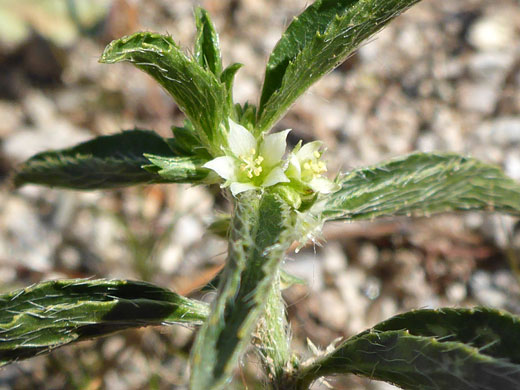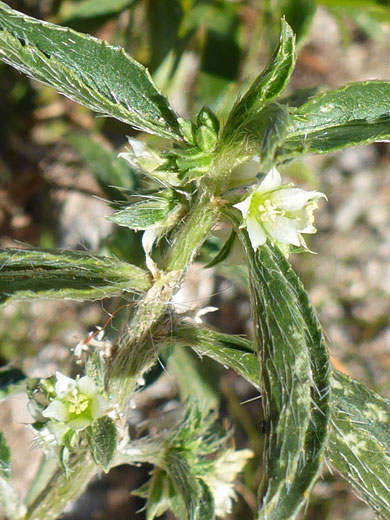Common names:
Yuma silverbush, New Mexico silverbush
Family:
Scientific name:
Ditaxis serrata
Synonym:
argythamnia serrata
Main flower color:
Range:
From California to Texas; most common in the Mojave and Sonoran deserts
Height:
Up to 20 inches
Habitat:
Sandy or gravelly places in deserts
Leaves:
Alternate, lanceolate to elliptic or spatulate, up to 2 inches long, with stipules
Season:
February to October
The species name for ditaxis serrata references the leaves, which are lined with small, sharp teeth (serrate), especially towards the tip. Leaves are somewhat variable in shape but generally narrow, and may be sparsely to densely covered with long, appressed, silvery-white hairs (var serrata), or essentially hairless (var californica). Leaves are at alternate intervals, from the base to the top of the stem. Stems are similarly hairy, often appearing white.
Plants are monoecious, with pistillate and staminate flowers; both have five pale green sepals and five greenish-white petals, and are small, only around 0.2 inches across. The latter have between five and 15 stamens, some shorter than the others. The lower portion of the stamens are fused into a short column. Pistillate flowers have long hairs on the petal undersurfaces, extending beyond the petal tips.
Plants are monoecious, with pistillate and staminate flowers; both have five pale green sepals and five greenish-white petals, and are small, only around 0.2 inches across. The latter have between five and 15 stamens, some shorter than the others. The lower portion of the stamens are fused into a short column. Pistillate flowers have long hairs on the petal undersurfaces, extending beyond the petal tips.
All Contents © Copyright The American Southwest | Comments and Questions | Contribute | Site Map









